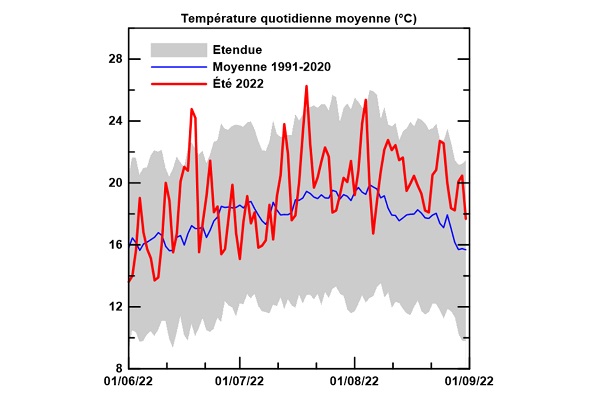 Mean daily temperature of summer 2022 in Clemency (red) compared to the reference period 1991−2020 (blue). The range is defined by the average of the minima and maxima of the mean daily temperature (in grey).;
Credit: AgriMeteo / ASTA
Mean daily temperature of summer 2022 in Clemency (red) compared to the reference period 1991−2020 (blue). The range is defined by the average of the minima and maxima of the mean daily temperature (in grey).;
Credit: AgriMeteo / ASTA
A new weather report has confirmed that the summer of 2022 was the second hottest summer ever recorded in Luxembourg.
As summer 2022 draws to a close, AgriMeteo, the national meteorological service of the ASTA (Administration des services techniques de l'agriculture) of Luxembourg's Ministry of Agriculture, Viticulture and Rural Development, has published its weather analysis for the period from 1 June to 31 August 2022.
The analysis looked at the network of 36 automatic weather stations across the Grand Duchy. The three-month values of four representative stations, namely Asselborn (north), Clemency (south-west), Remich (Moselle) and Luxembourg City (centre), were compared with the averages of the reference period 1991-2020.
In terms of temperatures, the summer of 2022 was the second hottest, after that of 2003, since records began in 1838, with an average temperature of 19.3°C. Two records were broken, with this year's summer being that with the most summer days (i.e. over 25°C) and the most "heat peaks" (brief periods of excessive heat, i.e. over 30°C). In terms of rainfall, it was the driest summer since 1921 and the seventh driest since records began in 1854. Heatwaves and the lack of rain that has persisted since March have caused an unprecedented drought.
June: too hot and too dry
With excesses between +0.9°C and +1.6°C, the month of June 2022 was warmer than the climatic average for 1991-2020. Precipitation was lacking in almost the entire country, except in Asselborn where the weather stations recorded a surplus of +5.2 mm compared to the average.
July: heatwaves and drought
July 2022 was marked by heatwaves and droughts. Temperatures were higher than normal and rainfall deficits ranged from -67.5 mm to -54.6 mm. In almost all of the Grand Duchy, except in Mamer, Reckange and Roeser, precipitation levels were below 10 mm. July 2022 was the second driest July on record since 1854.
August: too high temperatures and drought
Across the country, August 2022 was the hottest since monthly averages were recorded in 1838 and showed excesses between +2.5°C and +3.4°C. The drought continued with rainfall deficits of up to -66.6 mm. The month ended with locally intense showers.








